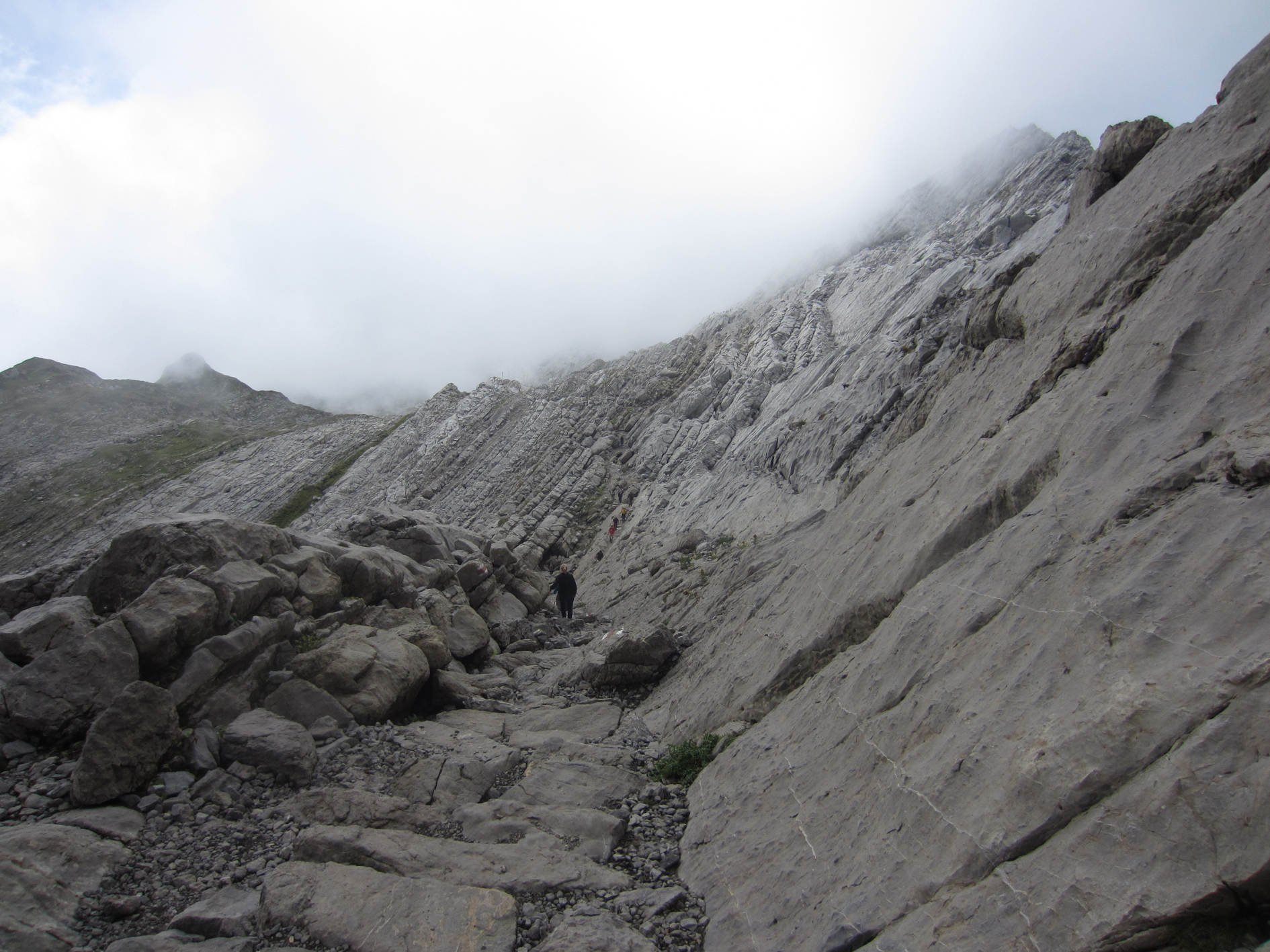Rawil-Member
Back to Aig. Rouges MassifRepresentation and status
- Index
- c5R
- Color CMYK
- (31%,0%,13%,24%)
- Color RGB
- R: 135 G: 195 B: 170
- Rank
- lithostratigraphic Member (Subformation)
- Validity
- Unit is in Use
- Status
- informal term
- Scs Note
-
Bewilligt als Ersatz zu dem alten Begriff «Untere Orbitolinen-Schichten». Informell, solange bis ein lithologisch typisches Profil publiziert worden ist.
- Scs Date
- 18.10.2007
- Status discussion
Nomenclature
- Deutsch
- Rawil-Member
- Français
- Membre du Rawil
- Italiano
- Membro del Rawil
- English
- Rawil Member
- Origin of the Name
- Historical Variants
-
Rawil-Schichten (Schenk 1992), Rawil Member = Rawil Beds = lower Orbitolina Beds (Föllmi et al. 2007), Rawil-Member (SKS 2009), Rawil Member (Bonvallet 2015), Rawyl-Member
- Nomenclatorial Remarks
-
«Unteren Orbitolinen-Schichten» auct., Marnes noirâtres à Orbitolines (Rollier 1917), Mergelschiefer-Einlagerungen (Heim 1917), Mergelband (Alexander et al. 1965), niveau à Orbitolina lenticularis auct. = brèche à Orbitolines (Plancherel 1998)
Description
- Description
-
Abfolge von dünnbankigen Biogenkalken und Mergeln, sowie gelb-beigen Mikritkalken. Zyklen mit jeweils kohligen Schmitzen im Dach. Thinning- und shallowing-up. Quarzsand nimmt im Zyklus gegen oben zu. Bis zu 4 Zyklen.
SKS2009a: Das Rawil-Member umfasst in der Regel detritusführende Kalke und Mergel, die einen oft dunkleren, mergelreicheren Abschnitt innerhalb der Schrattenkalk-Formation bilden. S.364
- Geomorphology
- Mergeliges-kalkiges Band inmitten des massiven Schrattenkalkes.
- Thickness
- 1-2 bis 30 m; bis max. 40 m (Föllmi et al. 2007)
Components
- brachiopods
- echinoids
- orbitolinids
Orbitolina lenticularis, Rhynchonella gibbsi, Heteraster oblongus
Hierarchy and sequence
- Superordinate unit
- Units at floor
- Upper boundary
-
Oft Übergänge zum hangenden Teil des Schrattenkalks.
- Lower boundary
-
Oft Übergänge zum liegenden Teil des Schrattenkalks.
Age
- Age at top
-
- Early Aptian
- Note about top
-
frühe weissi-Zone (Föllmi et al. 2007); Bedoulien
- Age at base
-
- Earliest Aptian
- Note about base
-
oglanlensis-Zone (Föllmi et al. 2007); Bedoulien ; basal Aptian (Bonvallet 2015)
- Dating Method
-
Orbitolinen-Biostratigraphie (Bollinger 1988, Schenk 1992, Arnaud et al. 1998, Arnaud-Vanneau et al. 1976)
Geography
- Geographical extent
- Zentrale und östliche Schweizeralpen.
- Type area
- Berner Helvetikum
- Type profile
-
-
Rawilpass (BE)/(VS)
Coordinates- (2600580 / 1136880)
- <p>ENE Rawilpasshöhe; dieses Profil ist nicht sehr charakteristisch, da sehr kalkreich: üblicherweise hebt sich das Rawil-Mb. vor allem durch den Gehalt an Mergel von der Schrattenkalk-Fm. ab.</p>
-
Rawilpass (BE)/(VS)
- Reference profiles
-
-
Lopper (NW)
Site particularities- typische Fazies
- (2667875 / 1203180)
- Kaufmann 1876 : typische mergelige Fazies (eine detaillierte Beschreibung fehlt).
-
Lopper (NW)
- Point of interest
-
-
Pilatus (OW)
Site particularities- spezielle Fazies
- Grat
- (2661925 / 1203225)
- Wurzelboden
-
Pilatus (OW)
Palaenography and tectonic
-
- Middle Cretaceous
- Cretaceous of the Helvetics
- Paleogeography
-
North Tethyan Shelf
:
marge continentale européenne - Tectonic unit (resp. main category)
- Kind of protolith
-
- sedimentary
- Metamorphism
- non metamorphic
References
- Definition
-
(1992) :
Die Drusberg- und Schrattenkalk-Formation (Unterkreide) im Helvetikum des Berner Oberlandes. Diss. Univ. Bern
Schenk 1992: lokale, Detritus-arme und kalkreiche Vorkommen der "Unteren Orbitolinen-Schichten"
S.42: Zusammenfassung: bis 30 m mächtige Abfolge von dünnbankigen Biogenkalken und gelb-beigen Mikritkalken. Zyklen mit jeweils kohligen Schmitzen im Dach. Thinning- und shallowing-up. Quarzsand nimmt im Zyklus gegen oben zu. Bis zu 4 Zyklen.
- Definition
-
(2007) :
Unlocking paleo- environmental information from Early Cretaceous shelf sediments in the Helvetic Alps: stratigraphy is the key! Swiss J. Geosci. 100, 349-369
S.11: The deposition of the Urgonian lithological unit was interrupted by a phase of increased input of detrital material and the temporary disappearance of photozoan carbonate producting organisms such as corals and rudists near the Barremian-Aptian boundary. This short heterozoan phase led to the deposition of a heterogeneous, up to 40 m thick succession of marly carbonates and silty or sandy marls, which were traditionally named “lower Orbitolina Beds” (Fig. 2; Heim 1910–1916; Oberholzer 1933; Fichter 1934; Lienert 1965). Schenk (1992) introduced the name “Rawil Beds” for the occurrences of this lithological unit in the southern part of the Bernese Swiss Alps. She reserved this lithostratigraphic term for distal, several tens of meters thick and internally well differentiated occurrences, whereas the sandy and calcareous occurrences in more proximal areas were still considered as “lower Orbitolina Beds”. Her definition is extended here to all Helvetic occurrences.
The Rawil Member frequently shows layers of pack- and grainstone rich in orbitolinids and is locally enriched in echinoids, gastropods, brachiopods, and bivalves. Variegated paleosols containing wood fragments occur in the region of Lopper (NE of Pilatus) and Tierwis (western part of the Säntis). The sequence stratigraphic context of this member is not clear yet, but the entire succession may represent a transgressive systems tract (Funk et al. 1993).
The age of the Rawil Member has been identified as earliest Aptian (oglanlensis to early weissi zones), based on orbitolinids and on correlations with occurrences in the Vercors realm (Bollinger 1988; Schenk 1992; Arnaud et al. 1998; Arnaud-Vanneau et al. 1976).

